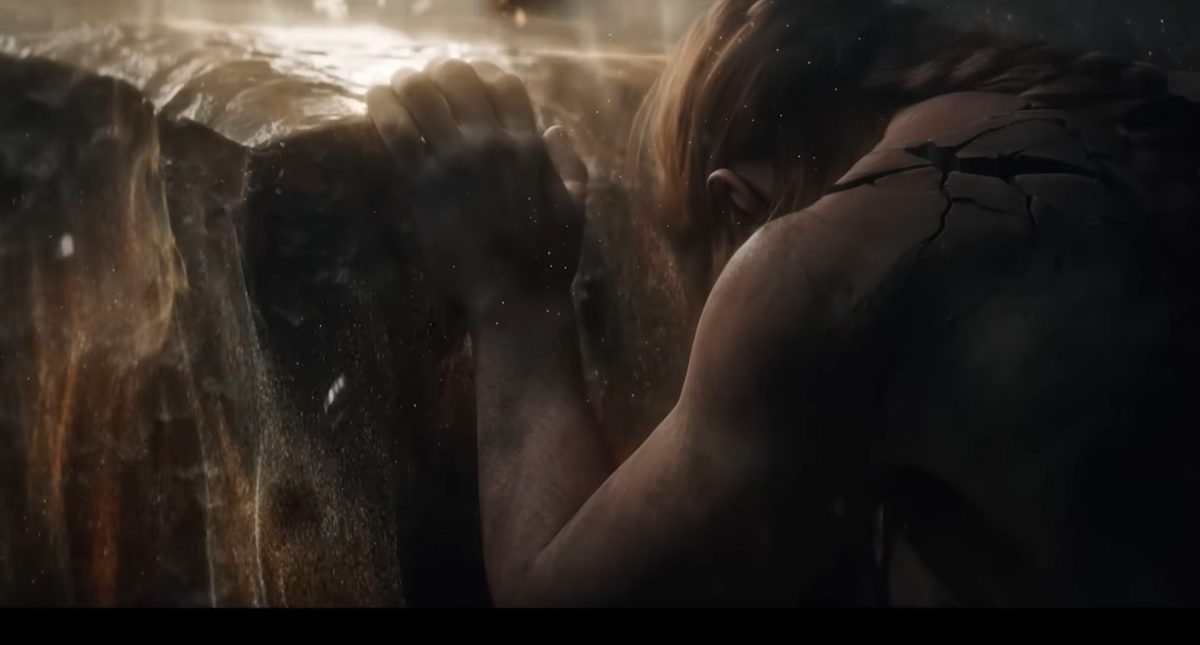The world of FromSoftware’s 2022 RPG Elden Ring is not governed by strictly realistic systems. Death has been abducted, the flow of time eddies around levitating islands, and Patches has been inexplicably reincarnated for a fourth time. Yet despite this, the game works within its own system of dream logic, focusing primarily on the relationships between and within characters. Elden Ring draws heavily on the alchemical processes of the Medieval, Renaissance, and Early Modern periods to create the Lands Between.
For the purposes of this essay, I will focus on two such characters: Queen Marika the Eternal, who serves as the ‘White Queen’ or femininely gendered mercury; and Radagon of the Golden Order, who functions as the ‘Red King’ or masculinely gendered sulfur. By assigning these characters to alchemical concepts, their titles and defined lines of gender begin to collapse into what alchemical texts refer to as the hermaphroditic res-bina (Rebis, or ‘two thing’). Thus, Marika and Radagon’s gender identity defies clean, modern labels, at once encapsulating / rejecting the gender binary while simultaneously upholding it through the gendered split in character design and language. Their Rebis can then be analyzed through Butlerian (1990) and Lacanian (2006) lenses to understand at least part of Elden Ring’s alchemical understanding of gendered identity.
Alchemical connections
First, we must establish Elden Ring’s alchemical connections. Alchemy itself is a movement spanning the Medieval, Renaissance, and Early Modern periods, leading to currents, countercurrents, and breakaway movements which neither I nor the game can cover in its entirety.
Elden Ring subtly incorporates general alchemical theming from across these periods into the main storyline, but focuses on specifically Renaissance alchemical literature for its depiction of gender. Notably, Renaissance alchemists took the concept of hermaphrodism from ‘impure hybrid’ to ‘productive transformation of the spiritual and physical’ (DeVun, 2021, pp. 72), shifting the understanding of gender roles and androgyny at the time via the Rebis, a ~14th century concept of a golden, doubly-gendered divine being following the union of feminine mercury (the White Queen) and masculine sulfur (the Red King) or, in Elden Ring, of Marika and Radagon.
This alchemical theming in Elden Ring is rendered apparent to players who have previous knowledge of the topic; yet it remains inconsequential for those who do not. The ‘Flask of Wondrous Physick’ is perhaps the most obvious alchemical denotation players will be exposed to by virtue of its ludic centrality via player healing and semantic centrality via unusual spelling, but the remainder of the game shapes itself around less prominent symbols. Crucible knights take their name from the chamber in which materials were melted and combined. Blood is used as a catalyst for transformational effects. Even the Elden Ring itself mirrors images drawn from the alchemical Ripley Scrolls — the list goes on.
As Leah DeVun discusses in The Shape of Sex (2021), the alchemical ‘marriage’ of gendered mercury with sulfur and subsequent production of the Rebis drew variously from Greco-Roman myths of double ‘proto-humans’, Ovid’s Metamorphosis, and early Christian concepts of both Adam and Christ’s androgyny. A variety of people would draw on these dual-gendered images in later attempts to explain and defend intersex people – such as Renaissance doctor Jaques Duval, the anonymous author of Isles of the Hermaphrodites, and even philosopher Michael de Montaigne. Alchemists of the late Medieval / early Renaissance used them as symbols to both maintain the occult mysticism surrounding their work while providing a legitimate basis to their practice.
Elden Ring used these concepts for similar purposes of legitimization (as a ‘serious game’1) and mysticism, though the way they are coded into the narrative differs. In game, the red-haired Radagon was invited to leave his wife and wed white-haired Queen Marika the Eternal following the banishment of her first consort. At some point following this event, the two had a set of twins before fusing together, becoming the Rebis and sharing a singular body if not a singular will. Marika, becoming disillusioned with the Elden Ring’s control, shatters the Ring; Radagon, doggedly following the guidance of grace, attempts to repair it. Despite Radagon’s efforts, Marika/Radagon would be imprisoned for this shattering. Should the player perform the ‘Law of Regression’ incantation before a statue of Marika, it will transform into a statue of Radagon and the message ‘Radagon is Marika’ will appear, thus revealing the central secret of their governance. Similarly, when the player enters the final boss arena of the game, Queen Marika will collapse, her hair will redden, and Radagon will combat the player, signalling a fight for control over one body.
This concept of a divided divinity is a new spin on the alchemical Rebis, where both characters simply are the other (as indicated by the statue inscription) yet differ in worldview. Furthermore, this physical domination by Radagon has overtones of domestic violence, wherein he overpowers Marika to ensure his will is done over hers. The distinction between these two characters raises a curious dilemma regarding communication of the difference in gendered identity – namely, are they a challenge to or proponent of the reductive gender binary?

Gender identity
Game characters exist in a curious state of limbo; they are not real, but are designed to be perceived as such by the player. Thus, they are the embodiment of performing gender ‘through the stylization of the body… the mundane way in which bodily gestures, movements, and styles of various kinds constitute the illusion of an abiding gendered self’ (Butler, 1993, p. 74, emphasis mine). Design for games must communicate who the created character is at a glance, involving stylization for denotations of gendered performance such as clothing, hairstyle, or movement. Furthermore, as games’ narratives have featured more complexity, weight must be given to the Lacanian school of thought which holds language as a way the self is constructed subliminally – gendered language such as pronouns or titles map on to societal/personal connotations (Lacan, 1966, p.3).
While criticisms of the former stylization model have been raised by trans scholars such as C. Riley Snorton (2009) and criticisms of the latter language model have been raised by Anglo-American feminists such as Joan Scott (1986), both are important for players’ understanding of game design. Marika and Radagon must immediately be recognizable as the same body yet seen and referred to as distinguishable, differently gendered selves. Where Queen Marika is consistently depicted with a dress and blonde hair, once Radagon takes control of their body the dress becomes a kilt, and their hair becomes bright red. While we never see Marika move, Radagon’s manner of movement consists of the long, aggressive strides often associated with masculinity.
Furthermore, while Marika and Radagon ostensibly share the same body a model swap occurs where Marika’s hourglass figure and breasts are less prominent when Radagon is in control. Yet despite these gendered stylizations, Marika and Radagon are recognizable as the same body due to the baseline androgyny present in their design – prominent muscles, a loose hairstyle, and flaking gray skin create a character adhering to masculinity and femininity in small details. This blend of androgynous baseline with specifically gendered aspects layered on top both complicates and flattens Elden Ring’s representation of gender,speaking to the previously mentioned Butlerian performative aspects. Lacanian lingual analysis is similarly applicable here – throughout the game, we are told about Radagon of the Golden Order, who is himself general of Queen Marika’s standing army. The former is masculine, identified by his function as an enforcer for the latter, whose femininity is reenforced by her title.
Much like their body, Marika and Radagon exist as a strange in-between of both queer challenge to and heteronormative upholding of gendered identity. Taken together, the two encapsulate and somewhat discard the gendered binary by creating an alchemically inspired androgynous being, blending masculine and feminine identities. Taken separately, the two uphold the gendered binary by playing into opposite ends of it, flattening the wide field of gender identity into the reductive, hegemonic dichotomy of male and female. Though there is a case to be made for Marika / Radagon as nonbinary representation, I find it a somewhat slippery slope to climb due to FromSoftware’s insistence upon their separate, gendered identities struggling for control over one body; instead of a complete being disrupting the gender binary, Marika and Radagon are two binarily gendered individuals who happen to be piloting the same vessel. I am always in favor of more expansive gendered representations in video games and support FromSoftware’s interesting alchemical basis in this case, but I wish it was used to go beyond the gender binary as a normative baseline.
Admittedly, the slow rate of progress regarding gender-expansive representation in games means that, while I think Elden Ring could have gone harder in this regard, it is still a step forward. The game’s DLC, Shadow of the Erdtree, does delve a bit deeper into alchemical representations of gender, with the dichotomy of Miquella and St. Trina alongside the character of Count Ymir, Mother of Fingers, providing fertile ground for future academic inquiry. For the moment, FromSoftware has taken an interesting direction, and I hope future titles take similar concepts beyond the gender binary for more nuanced applications of Butlerian and Lacanian analytical frameworks.
Marcus Jensen (he/him) is an undergraduate researcher at Oberlin College. He focuses on music history, queer theory, and media studies with a focus on video games. Previous work includes examinations of temporal collapse in Medievalist video game soundtracks, maternity in conjunction with witchcraft in video games, and the progression of ludic queer representation. When not writing, he enjoys gardening and baking. You can find Marcus on instagram @marcouscous.j.
- I use this term to denote Elden Ring’s action toward / status as a relatively mainstream game, though the quotations marks are to signal my annoyance with the term’s usage in diminishing the achievements of lighter, non-mainstream, non-RPG games. ↩︎
Citations
Butler, J. (1990). Gender Trouble: Feminism and the Subversion of Identity. New York: Routledge.
DeVun, L. (2021). The Shape of Sex: Nonbinary Gender from Genesis to the Renaissance. Columbia University Press. http://www.jstor.org/stable/10.7312/devu19550
Lacan, J., & Fink, B. (2006). Ecrits: The first complete edition in English. New York, W.W. Norton & Co.
Parasoulsus. (2021). Elden Ring’s deep connection to alchemy and the Ripley Scroll. r/Eldenring, reddit.
Scott, J. (1986). Gender: A Useful Category of Historical Analysis. The American Historical Review, vol. 91, no. 5. pp. 1053–1075. https://doi.org/10.2307/1864376
Snorton, C. R. (2009) A New Hope: The Psychic Life of Passing. Hypatia, vol. 24, no. 3. Hypatia Inc.
Games discussed
FromSoftware (2022). Elden Ring. Digital game directed by Hidetaka Miyazaki, Yui Tanimura, and George R.R. Martin, published by Bandai Namco Entertainment.
